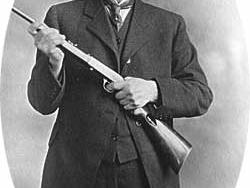USA
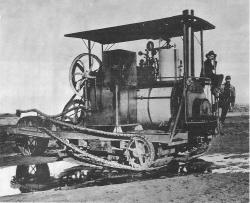
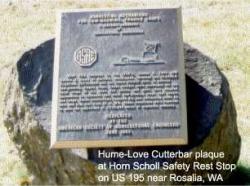
Near This Location In The 1930's James E. Love And Horace D. Hume Of Garfield, Washington, Invented The Flexible Floating Cutterbar And The Tined Pickup Reel To Harvest Low-Growing, Fragile Crops. These Devices Were Developed For The Local Crops Of Dry Peas And Lentils And Were Then Adopted Nationwide To Soybeans And Other Low-Growing Crops That Tangle And Lodge. These Mechanisms Reduced Dry Pea Harvesting Costs By 28% And Crop Loss From 50 To 10%. These Inventions Were Reported To Save The Equivalent Of 2,750,000 Acres Of Soybeans Annually.
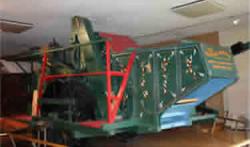
The Sidehill Combine Developed By The Holt Brothers At Stockton, California In 1891, A Significant Milestone In Grain Harvesting And Agricultural Efficiency That Opened New Land For Wheat Farming, Is Designated A Historic Landmark Of Agricultural Engineering By The American Society Of Agricultural Engineers 1982

Tests Of Grain Aeration To Cool And Dry Combine-Harvested Wheat By F. L. Fenton, C. O. Swanson, And Orval C. French At Kansas State University In 1930-31 Showed Mechanical Ventilation To Be More Effective Than Natural Draft Ventilation. Mechanical Aeration Was Further Developed In The 1940's To Prevent Moisture Migration, Which Caused Wetting And Spoilage Of The Top Layers Of Stored Grain. Studies In 1944-45 By Usda Agricultural Engineers G. W. French And W. V. Hukill Cooperating With Iowa State University Proved That Mechanical Aeration Prevented Moisture Migration. G. H.

Preventing Wind Erosion Was The Primary Objective Of Fred Hoeme, a Hooker, Oklahoma Farmer, When He Developed A Heavy-Duty Chisel Plow In 1933. Hoeme And His Sons Manufactured And Sold About 2000 Plows From Their Farmstead. In 1938, W. T. Graham Purchased The Manufacturing And Distribution Rights And Established Manufacturing In Amarillo, Texas. The Graham-Hoeme Plow, Marketed As "The Plow To Save The Plains", Was Sold Worldwide.
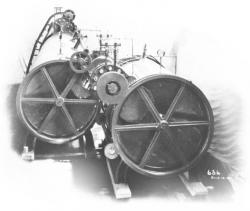
The Food Canning Industry Was Revolutionized In 1920, When The Continuous Rotary Pressure Sterilizer Was Introduced By Albert R. Thompson. Thompson Was Chief Engineer For The Anderson-Barngrover Co. Of San Jose, California, Now The FMC Corporation. The Sterilizer Cooked Canned Products Uniformly Under Pressure For Short Period At High Temperatures, Then Quickly Cooled Them Under Pressure To Prevent Swelling Or Bursting. It Operated Continuously At Speeds Of Up To 400 Cans Per Minute.
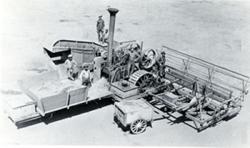
George Stockton Berry (1847-1917) of Lindsay, Tulare County, California designed, built, and in 1886, operated the first self-propelled combine. He was granted a U.S. Patent (# 374,339) in1887. The Berry design embodied the following "firsts":
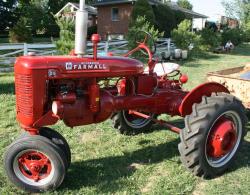
The First Successful Row Crop Tractor Invented by Bert R. Benjamin (ASAE Member) was Operated and Tested on this Farm in 1923. Increased Row Crop Clearance and Overall Versatility Extending the Use of the Tractor to Cultivating, Accelerated the Conversion from Animal Power to Machine and Marked a New Era in American Agricultural Efficiency and Productivity. Dedicated by The American Society of Agricultural Engineers 1980
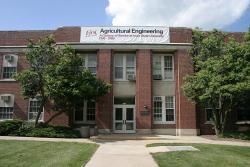
Designated an Historic Landmark in Honor of J. Brownlee Davidson a Founder of Agricultural Engineering First President of American Society of Agricultural Engineers Organizer of the First Professional Agricultural Engineering Curriculum July 1905 by American Society of Agricultural Engineers
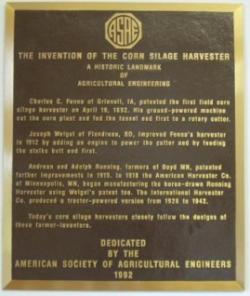
Charles C. Fenno Of Grinnell, Ia, Patented The First Field Corn Silage Harvester On April 19, 1892. His Ground-Powered Machine Cut The Corn Plant And Fed The Tassel End First To A Rotary Cutter. Joseph Weigel Of Flandreau, Sd, Improved Fenno's Harvester In 1912 By Adding An Engine To Power The Cutter And By Feeding The Stalks Butt End First. Andrean And Adolph Ronning, Farmers Of Boyd, Mn Patented Further Improvements In 1915. In 1918 The American Harvester Co. Of Minneapolis, Mn, Began Manufacturing The Horse-Drawn Ronning Harvester Using Weigel's Patent Too.
Innovations

Built by the Bay City Dredge Works of Bay City, Michigan, this dredge was used to construct a portion of US 41 called the Tamiami Trail, which connected Tampa with Miami through the Everglades and Big Cypress Swamp. The last remaining display of walking dredges (of some 145 walking machines), it…
Read More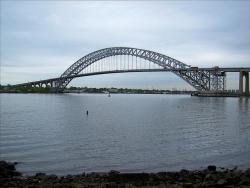
The longest steel-arch bridge in the world for 46 years, the Bayonne Bridge continues to be celebrated today as a major aesthetic and technical achievement. The 1,675-foot bridge replaced a ferry service which until then was the only means of crossing from the Bayonne peninsula to Staten Island…
Read More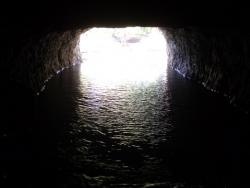
Montogomery Bell was a land developer and iron maker who purchased the Harpeth Narrows site to expand his industrial empire - which ultimately consisted of 14 iron blast furnaces throughout middle Tennessee.
The Harpeth River makes a tight bend around a steep limestone ridge, losing 17…
Read More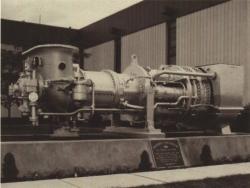
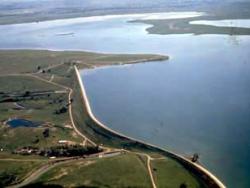
Belle Fourche, meaning "Beautiful Forks" in French, refers to the confluence of the Redwater and Belle Fourche Rivers. The gold rush to the Black Hills in 1876 brought many people to the area, but agriculture and livestock soon became the principal industries. Farmers and civic leaders…
Read More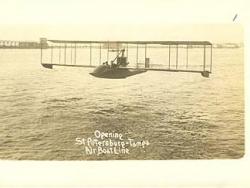
The St. Petersburg Yacht Basin was the original operating location of the St. Petersburg – Tampa Airboat Line, the nation’s first, regularly-scheduled commercial airline. The line’s inaugural flight was on January 1, 1914, with two daily, round-trip flights between St. Petersburg, Fla., and…
Read More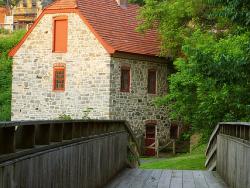
The first known pumping system providing drinking and wash water in the North American colonies. The building (still standing) is dated 1761, but it was preceded by an experimental frame building dated 1754. Before the Bethlehem built its system, assigned carriers would daily haul water up the…
Read More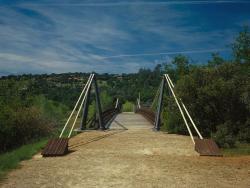
Soon after gold was discovered at Sutter's Mill near Sacramento in 1848, General John Bidwell found gold near the Middle Fork of the Feather River. His discovery brought hordes of miners to the scene and Bidwell Bar was born. The Bidwell Bar Suspension Bridge over the Feather River was one of…
Read More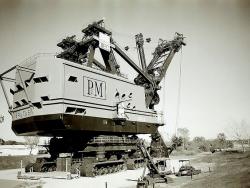

All building materials were made fire-resistant to protect against incendiary bombing. Treatment involved a vacuum process of salt impregnation. During construction, high winds caused a partial collapse of some members. The ruined materials were piled for incineration, but would not burn; so the…
Read More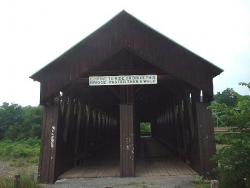
Nicholas Montgomery Powers built the bridge. It was first constructed behind the village, then taken apart and reassembled over the stream. Some residents questioned the idea of re-constructing it, but Powers was so confident of the bridge's durability that he sat on the roof when the final…
Read More

By the 1890s, the transportation infrastructure of downtown Boston - a maze of narrow, winding streets laid out, in some cases, along Colonial cow paths - proved completely inadequate for the needs of a modern, bustling metropolis. Tremont Street, the city's main thoroughfare, was regularly…
Read More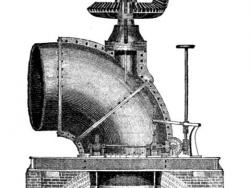
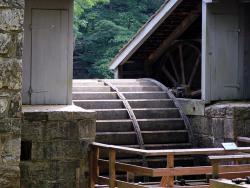
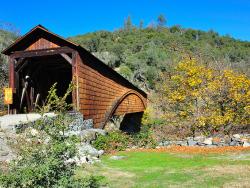
A product of the Northern California Gold Rush, the Bridgeport Covered Bridge is believed to be the longest, single-span, wooden covered bridge in the United States. Crossing the south fork of the Yuba River at a span of 233 feet, the bridge was built by the Virginia City Turnpike Company as…
Read More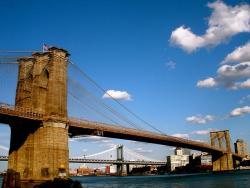
On May 24, 1883, with schools and businesses closed for the occasion, New York celebrated the opening of the Brooklyn Bridge. Also known as the Great East River Bridge, it was built over 14 years in the face of enormous difficulties. Deaths, fire in the Brooklyn caisson, and a scandal over…
Read More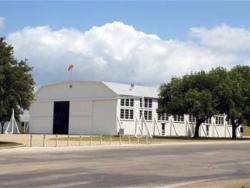
In its infancy, Hangar Nine housed Curtiss JN-4s ("Jennys") like the one Charles Lindbergh landed there when he reported for duty as a flying cadet in 1924.
As the U.S. was preparing to enter World War I, the Army raced to build an entire airfield, complete with 16 wooden hangars,…
Read More